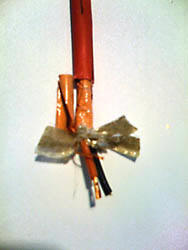
Circuit Integrity (CI) cable is an expensive method to ensure life safety circuits continue to function during a fire. At a cost of about $6 a foot, compared to $1.50 a foot for plenum rated fire alarm cable, why would an installer use this type of cable?
Well obviously because he has to, but why would he be made to use this? The bottom line is if a facility does not evacuate the entire building immediately or has a life safety system meant to serve individuals who can’t evacuate without assistance, the circuits that provide fire alarm notification have to be able to withstand a direct attack by fire for 2 hours until they get to the area they serve. That’s the definition of a CI cable, also referred to as 2 hour cable. You used to be able to install this cable free wire or in any conduit, but since UL initially de-listed the rating for these cables, they now have to be installed as part of a particular system of conduit, fittings and hangers.
What sort of facilities partially evacuate, re-locate or stay in place upon a fire alarm activation? High rises, hospitals, nursing homes, prisons/jails/detention facilities and some schools have fire response plans that fit this description. Does the entire circuit have to use CI cable? No, just until it’s in a 2 hour rated riser or until it reaches the actual space it serves. For example, in a high rise where the 30th floor speaker circuit originates from a panel in a 1st floor electrical room & travels across the floor to get to a 2 hour rated vertical pipe chase that runs the height of the building with closets on each floor, the circuit has to use CI cable to get from the electrical room until it reaches the pipe chase closet on the 1st floor. After that, it’s in a 2 hour rated space until it reaches the 30th floor, so the horizontal portion on the 1st floor is the only portion that needs 2 hour protection.
Hospitals are more difficult & expensive. They have 2 hour smoke zones that are designated for others to re-locate to & shelter in place if needed, so their notification circuits must be able to withstand 2 hours of fire until they reach their particular zone. That means both the audible and visual circuits are dedicated to specific smoke zones and must be survivable until they reach their zone. The electrical designer of record needs to know this & call it out in the specification and on the bid drawings or they could face expensive change orders.
There are other methods of achieving 2 hour protection, but that’s the topic for another discussion. Affiliated Fire Systems has the experience, state of the art Gamewell-FCI by Honeywell equipment and staff to ensure you’re up to speed on issues such as this. We’ll work with you to find practical solutions before they become expensive problems. Contact us today for assistance on your design or quotations on projects you’re bidding on.
Gene Rowe, SET NICET IV, Fire Alarm Systems


Thanks Gene, very clear and helpful